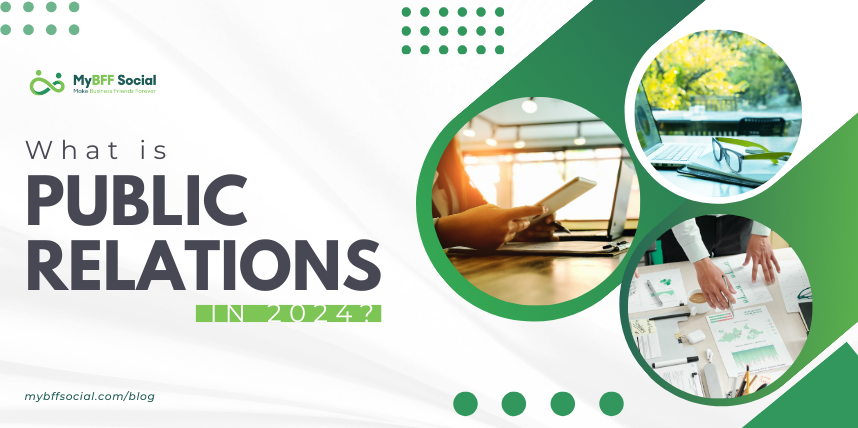
Public relations is the strategic communication process that builds mutually beneficial relationships between organizations and their publics. The “publics” can include customers, employees, investors, media, government, and the general public. PR professionals aim to create a positive perception of their organization through various channels and tactics, including media relations, social media engagement, content creation, event management, and crisis communication.
The Evolution of PR in Contemporary Times
The advent of digital media has revolutionized PR, making it more dynamic and interactive. Here are some key changes:
- Digital and Social Media: Social media platforms like Twitter, Facebook, LinkedIn, and Instagram have become vital PR tools. They allow businesses to engage directly with their audience, respond to queries, and manage their online reputation in real-time.
- Content Marketing: Quality content is crucial in contemporary PR. Businesses create blogs, videos, podcasts, and infographics to inform, entertain, and engage their audiences. This content helps build authority and trust, driving organic traffic and brand loyalty.
- Influencer Partnerships: Collaborating with influencers can amplify a brand’s reach and credibility. Influencers have dedicated followings, and their endorsement can lead to increased visibility and trust among potential customers.
- Data and Analytics: Modern PR relies heavily on data to measure the effectiveness of campaigns. Analytics tools track engagement, reach, sentiment, and ROI, allowing PR professionals to fine-tune their strategies for maximum impact.
- Crisis Management: In the digital age, news spreads rapidly. Effective crisis management is crucial to mitigate damage to a company’s reputation. PR professionals must be prepared to respond swiftly and transparently to any negative events.
How PR Can Help Businesses Increase Growth
Effective public relations strategies can significantly contribute to business growth in various ways:
1. Building Brand Awareness
One of the primary roles of PR is to increase brand visibility. By securing media coverage, engaging on social media, and creating compelling content, PR professionals can put a brand in front of a broader audience. Consistent visibility helps potential customers recognize and remember the brand, which is the first step towards conversion.
2. Enhancing Credibility and Trust
Trust is a crucial factor in consumer decision-making. PR helps build credibility through third-party endorsements, media coverage, and influencer partnerships. When a reputable source speaks positively about a brand, it carries more weight than traditional advertising. PR also involves managing a company’s reputation by addressing negative feedback and showcasing positive stories.
3. Driving Customer Engagement
Engaging directly with customers through social media, blogs, and other platforms fosters a sense of community and loyalty. PR campaigns that encourage interaction, such as contests, Q&A sessions, and user-generated content, can strengthen relationships with existing customers and attract new ones.
4. Supporting Product Launches
Launching a new product or service requires careful planning and execution. PR can generate buzz and excitement through pre-launch teasers, press releases, influencer collaborations, and launch events. A well-coordinated PR campaign ensures that the target audience is aware of the new offering and its benefits, driving initial sales and adoption.
5. Managing Crises
Every business faces challenges, and how they handle them can make or break their reputation. PR professionals are trained to manage crises by providing clear, honest, and timely communication. Effective crisis management can mitigate damage, reassure stakeholders, and even turn a negative situation into an opportunity for demonstrating the company’s values and resilience.
6. Influencing Public Perception
PR strategies can shape public perception by controlling the narrative around a brand. This includes highlighting positive aspects, such as corporate social responsibility (CSR) initiatives, sustainability efforts, and community involvement. By aligning the brand with values that resonate with the audience, PR can foster a positive image that differentiates the company from competitors.
7. Supporting Sales and Marketing Efforts
PR and marketing are closely intertwined. Effective PR can amplify marketing campaigns, generating more leads and sales. For instance, media coverage of a new product can complement advertising efforts, reaching a wider audience and reinforcing the marketing message. PR can also provide valuable insights into consumer behavior and preferences, informing marketing strategies.
Conclusion
In contemporary times, public relations is more than just managing media relations; it is about creating and maintaining a positive relationship with all stakeholders. Through strategic communication, PR helps businesses build brand awareness, enhance credibility, drive engagement, support product launches, manage crises, and influence public perception. As a result, effective PR contributes significantly to business growth, making it an indispensable component of modern business strategy. In an era where reputation and relationships are paramount, businesses that invest in robust PR practices are better positioned to thrive and succeed.
Ready to elevate your company’s public perception and drive success through effective marketing strategies? Contact BFF Social today to discover how we can help you develop and implement a comprehensive marketing plan that resonates with your audience and achieves your business goals. Our team of experts is here to guide you every step of the way.
We are pleased to announce a partnership with DesignRush as one of the top Pittsburgh advertising agencies! Check out their list here: Top Pittsburgh Advertising Agencies
